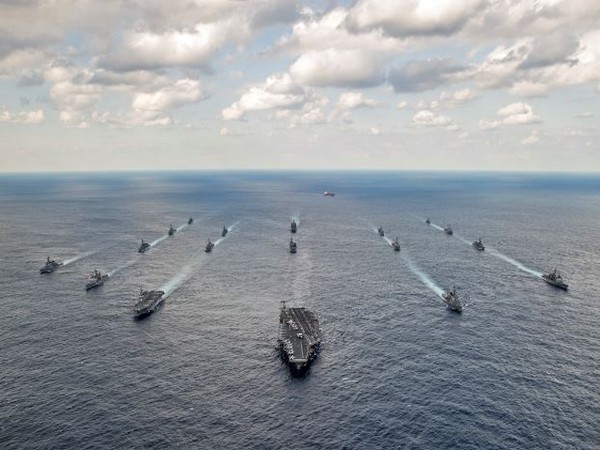Chinese Navy simulates attack on US Navy warships in South China Sea
Beijing [China], January 1 (ANI): Amid growing tensions between China and the US over Beijing’s growing aggression in the South China Sea, the Chinese Navy simulated an attack on an American Navy task group on December 21, the same day that a Chinese J-11 fighter jet intercepted a US Air Force RC-135 surveillance aircraft, in what the Pentagon termed an “unsafe manoeuvre,” reported The Drive.

On December 21, according to the SCS Probing Initiative, the US military sent three P-8A maritime patrol aircraft, one RC-135V surveillance aircraft, and one E-3G airborne early warning and control aircraft from Clark Air Base and Kadena Air Base to operate over the South China Sea and south of the Taiwan Strait.
The RC-135V in question could very well have been the one intercepted by the J-11. Meanwhile, the PLAN’s most recently inducted aircraft carrier, Shandong, has also conducted previous exercises in the region, as have U.S. Navy carrier strike, groups.
“As part of that exercise, a strike group led by the Shandong simulated attacks on a US Navy formation,” an official from an unnamed Asian country disclosed to the Financial Times.
Intense Chinese military activity in the South China Sea is hardly unusual, although it’s interesting to note that, in this case, the exercise scenario apparently targeted US Navy vessels specifically.
Indeed, it’s highly conceivable that the RC-135 that was intercepted was monitoring the same Chinese military drill as it unfolded in the air and in the waters of the South China Sea, reported The Drive.
Notably, as of December 21, the PLAN also had another carrier task group conducting large-scale exercises, this time with Liaoning operating in the Philippine Sea. The ability of the PLAN to carry out simultaneous large-scale carrier operations in two different locations is a significant one, as carriers and out-of-area operations become more central to its concept of operations.
In fact, the intensity of US carrier operations in the South China Sea has picked up in recent years. In July 2020, for example, two Nimitz class aircraft carriers, the USS Nimitz and USS Ronald Reagan took part in the first dual-carrier exercise held there in six years, reported The Drive.
Overall, the events of December 21 reflect the patterns of activity that are increasingly commonplace for both China and the United States in the region.
Beijing claims the bulk of the South China Sea as its sovereign territory, contributing to this being the region’s most hotly contested body of water. Such claims are bolstered by China’s construction of controversial man-made islands in the region, reported The Drive.
These outposts have become increasingly militarized, part of China’s strategy for enforcing its expansive territorial claims despite significant international opposition. The same strategy also involves paramilitary vessels that are used to impede other nations’ access to fishing areas and energy resources.
While the precise location of the RC-135 intercept, and of the simulated attacks on the US Navy by the Shandong strike group, remain unclear, the issue of Taiwan also plays into the geopolitical backdrop of these and similar incidents, reported The Drive.
The Chinese leadership has taken an increasingly aggressive stance toward Taiwan in recent years, while officials in the United States are now more openly expressing concerns that Beijing may seek to take control of the island sooner rather than later.
Some actions by Chinese aircraft in recent months have been more overtly threatening. A case in point is the incident in May this year, when an Australian P-8A was damaged by countermeasures launched by a Chinese J-16 Flanker fighter jet over the South China Sea, according to the Australian Department of Defense, reported The Drive.
Beijing frames military activities by the United States and its allies as a threat to peace in the region, issuing sharp rebukes to US Navy warships conducting so-called Freedom of Navigation Patrols, or FONOPs. Meanwhile, its claims over most of the South China Sea and Taiwan remain steadfast.
Meanwhile, there is a clear requirement for the US military to monitor Chinese activities in the region, including exercises, but also gather any kind of intelligence that could shed light on the capabilities of PLAN aircraft and ships, tactics, techniques, and procedures.








